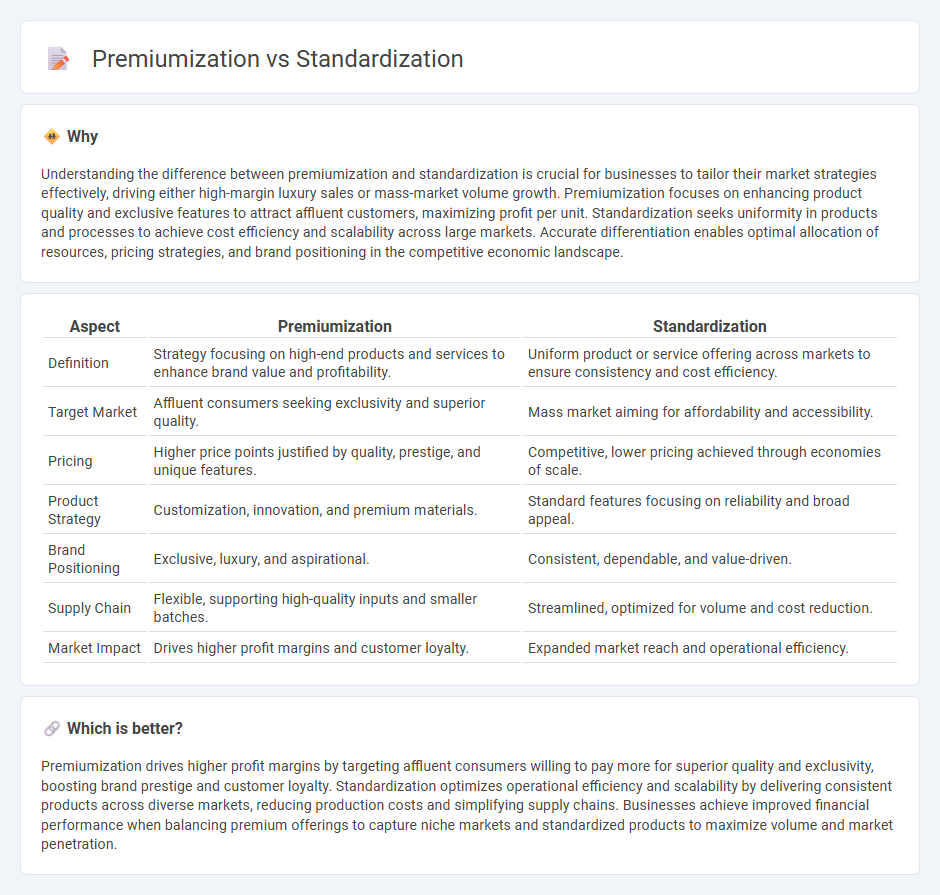
Premiumization focuses on enhancing product quality, exclusivity, and customer experience to target affluent consumers, driving higher profit margins and brand prestige. Standardization prioritizes uniformity, cost efficiency, and mass production to appeal to a broader market by delivering consistent value at scale. Discover how these contrasting strategies influence market dynamics and inform business growth decisions.
Why it is important
Understanding the difference between premiumization and standardization is crucial for businesses to tailor their market strategies effectively, driving either high-margin luxury sales or mass-market volume growth. Premiumization focuses on enhancing product quality and exclusive features to attract affluent customers, maximizing profit per unit. Standardization seeks uniformity in products and processes to achieve cost efficiency and scalability across large markets. Accurate differentiation enables optimal allocation of resources, pricing strategies, and brand positioning in the competitive economic landscape.
Comparison Table
| Aspect | Premiumization | Standardization |
|---|---|---|
| Definition | Strategy focusing on high-end products and services to enhance brand value and profitability. | Uniform product or service offering across markets to ensure consistency and cost efficiency. |
| Target Market | Affluent consumers seeking exclusivity and superior quality. | Mass market aiming for affordability and accessibility. |
| Pricing | Higher price points justified by quality, prestige, and unique features. | Competitive, lower pricing achieved through economies of scale. |
| Product Strategy | Customization, innovation, and premium materials. | Standard features focusing on reliability and broad appeal. |
| Brand Positioning | Exclusive, luxury, and aspirational. | Consistent, dependable, and value-driven. |
| Supply Chain | Flexible, supporting high-quality inputs and smaller batches. | Streamlined, optimized for volume and cost reduction. |
| Market Impact | Drives higher profit margins and customer loyalty. | Expanded market reach and operational efficiency. |
Which is better?
Premiumization drives higher profit margins by targeting affluent consumers willing to pay more for superior quality and exclusivity, boosting brand prestige and customer loyalty. Standardization optimizes operational efficiency and scalability by delivering consistent products across diverse markets, reducing production costs and simplifying supply chains. Businesses achieve improved financial performance when balancing premium offerings to capture niche markets and standardized products to maximize volume and market penetration.
Connection
Premiumization and standardization intersect by balancing product exclusivity with operational efficiency, enabling companies to cater to diverse market segments while maintaining cost-effectiveness. Premiumization drives higher profit margins through enhanced quality and brand perception, whereas standardization ensures consistent production processes and scalability across markets. This strategic integration supports sustainable growth by aligning luxury appeal with streamlined supply chains.
Key Terms
Market Segmentation
Market segmentation plays a crucial role in balancing standardization and premiumization strategies, as companies must align products with distinct consumer groups based on income, preferences, and buying behavior. Standardization targets mass markets by offering uniform products at competitive prices, whereas premiumization appeals to niche segments seeking higher quality and exclusive features. Explore more on how effective market segmentation drives strategic decisions between standardized and premium product offerings.
Value Proposition
Standardization emphasizes consistent quality and cost-efficiency to appeal to a broad market, offering reliable value through uniform products or services. Premiumization targets niche segments by enhancing product features, exclusivity, and brand perception to justify higher prices and create superior value. Explore how aligning your value proposition with these strategies can optimize market positioning and customer loyalty.
Pricing Strategy
Standardization pricing strategy emphasizes uniform prices across markets, enhancing cost efficiencies and brand consistency, while premiumization leverages higher prices to reflect superior quality and exclusivity, targeting affluent consumers and boosting profit margins. Brands employing premiumization often utilize psychological pricing and value-based tactics to justify price premiums, whereas those favoring standardization prioritize competitive parity and operational simplicity. Discover how mastering these pricing strategies can optimize market positioning and revenue growth.
Source and External Links
Standardization - Definition, Goal and Example, Effects - Standardization is the process of creating protocols to guide the creation of goods or services based on industry consensus, ensuring consistent quality, safety, interoperability, and compatibility across products and business operations.
What Is Standardization? - Standardization involves developing, promoting, and enforcing standards-based compatible technologies and processes to ensure quality, consistency, interoperability, and safety within an industry.
Standardization - Standardization is the consensus-driven process of implementing technical standards to maximize compatibility, safety, efficiency, and quality, and to coordinate mutually consistent decisions among various stakeholders.
 dowidth.com
dowidth.com